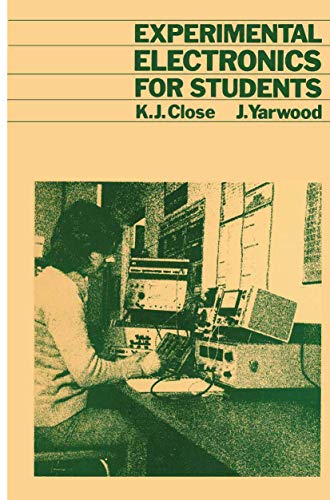Articoli correlati a Experimental Electronics for Students

Le informazioni nella sezione "Riassunto" possono far riferimento a edizioni diverse di questo titolo.
Le informazioni nella sezione "Su questo libro" possono far riferimento a edizioni diverse di questo titolo.
- EditoreSpringer Verlag
- Data di pubblicazione2011
- ISBN 10 9400957696
- ISBN 13 9789400957695
- RilegaturaCopertina flessibile
- Numero di pagine244
Compra nuovo
Scopri di più su questo articolo
Spese di spedizione:
GRATIS
In U.S.A.
I migliori risultati di ricerca su AbeBooks
Experimental Electronics for Students by Close, K. [Paperback ]
Descrizione libro Soft Cover. Condizione: new. Codice articolo 9789400957695
Experimental Electronics for Students
Descrizione libro Condizione: New. Codice articolo ABLIING23Apr0412070052497
Experimental Electronics for Students
Print on DemandDescrizione libro Condizione: New. PRINT ON DEMAND Book; New; Fast Shipping from the UK. No. book. Codice articolo ria9789400957695_lsuk
Experimental Electronics for Students
Descrizione libro Paperback. Condizione: Brand New. 244 pages. 9.25x6.10x0.55 inches. In Stock. Codice articolo x-9400957696
Experimental Electronics for Students
Descrizione libro Taschenbuch. Condizione: Neu. Druck auf Anfrage Neuware - Printed after ordering - Electronics is essentially an experimental subject and enables a wealth of experimental work to be undertaken at relatively low cost. In any modestly equipped electrical engineering or physics laboratory. it is possible to plan interesting experiments to study active and passive com ponents, basic circuit functions, modular encapsulations and monolithic integrated circuits. The work may range from the formal investigation of a device new to the student to the design and construction of quite advanced, modern measurement and control systems. There are few books which guide experimental work in electronics. This text aims to rectify this by giving detailed descriptions of a series of experiments all of which have been thoroughly tested by students in physics, electronics, electrical engineering and instrumentation at The Polytechnic of Central London. Moreover, several of these experiments would seem to be appropriate for the current development of interest in courses in electronics in schools because several of them have been undertaken with considerable success by first-year sixth-form students who have come to Central London for special courses. They would also assist an introductory course in electronics for students from other disciplines and have been tried out in this way at The Polytechnic. Codice articolo 9789400957695
Experimental Electronics for Students
Descrizione libro Condizione: New. Dieser Artikel ist ein Print on Demand Artikel und wird nach Ihrer Bestellung fuer Sie gedruckt. Electronics is essentially an experimental subject and enables a wealth of experimental work to be undertaken at relatively low cost. In any modestly equipped electrical engineering or physics laboratory. it is possible to plan interesting experiments to st. Codice articolo 5828764
Experimental Electronics for Students
Descrizione libro PF. Condizione: New. Codice articolo 6666-IUK-9789400957695
Experimental Electronics for Students
Descrizione libro Taschenbuch. Condizione: Neu. This item is printed on demand - it takes 3-4 days longer - Neuware -Electronics is essentially an experimental subject and enables a wealth of experimental work to be undertaken at relatively low cost. In any modestly equipped electrical engineering or physics laboratory. it is possible to plan interesting experiments to study active and passive com ponents, basic circuit functions, modular encapsulations and monolithic integrated circuits. The work may range from the formal investigation of a device new to the student to the design and construction of quite advanced, modern measurement and control systems. There are few books which guide experimental work in electronics. This text aims to rectify this by giving detailed descriptions of a series of experiments all of which have been thoroughly tested by students in physics, electronics, electrical engineering and instrumentation at The Polytechnic of Central London. Moreover, several of these experiments would seem to be appropriate for the current development of interest in courses in electronics in schools because several of them have been undertaken with considerable success by first-year sixth-form students who have come to Central London for special courses. They would also assist an introductory course in electronics for students from other disciplines and have been tried out in this way at The Polytechnic. 244 pp. Englisch. Codice articolo 9789400957695

